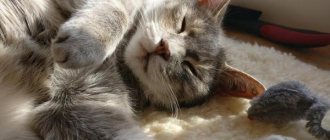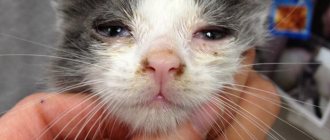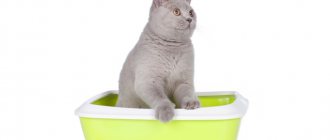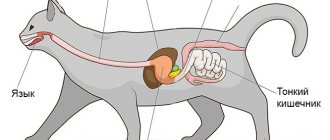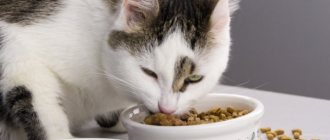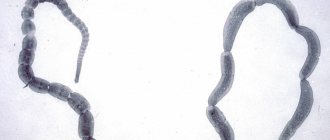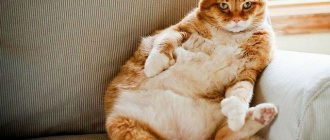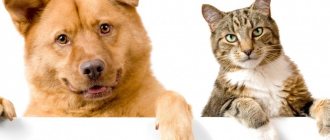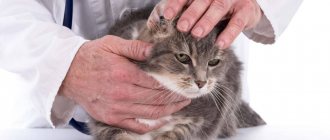Doctors often encounter misunderstandings among owners when they try to explain that the cat does not have constipation, but megacolon. What is the difference between these concepts?
Constipation (also referred to as constipation or constipation) is difficult or systematically insufficient defecation, that is, bowel movement.
Megacolon is a form of long-term constipation when the colon becomes full of hard and dried stool.
Constipation can most often be treated with medication, but sometimes it is necessary to resort to surgery.
Description
Megacolon is a chronic increase in the diameter of the large intestine, most often the colon.
This is where electrolytes and moisture are absorbed from the stool. Usually the excrement moves further, accumulating before the act of defecation in the rectum. With megacolon in cats, the movement of masses ends in the thick section. Excretion occurs due to peristalsis - wave-like contractions. Due to complete or partial loss of motility, a section of the intestine loses tone, increasing in diameter. A “pocket” is formed where feces accumulate, further drying and pressing.
Soon the density and volume of the masses reach values that make the natural process of emptying impossible. Fecal stones irritate the intestinal walls, which, against the background of chronic intoxication, leads to a deterioration in the general condition of the cat. Megacolon without treatment leads to irreversible changes in the nerves and smooth muscles of the colon, peritonitis, sepsis, failure of internal organs, and perforation of the intestinal walls.
This is not a separate disease, but a clinical sign of a disease or pathology. Maine Coons, Himalayans and Persians are prone to megacolon due to the structure of their pelvis. In the absence of specific causes, megacolon in cats is most often diagnosed between the ages of 4 and 7 years, secondary - regardless of age.
How to choose?
Not every remedy can be given to a little furry.
For Lactusan for cats and other laxatives to work effectively, you need to know what problem to treat and what to take. It is also important to take into account the age of the pet and the characteristics of the animal’s condition, since some medications are prohibited for kittens and can also harm pregnant cats and unborn babies. In case of acute constipation, it is recommended to choose laxatives that have a stimulating effect on the body. When broken stools lead to severe intoxication, it is better to choose special softeners. Osmotic medications help combat acute constipation in cats. The use of vegetable oil is possible only after consultation with a veterinarian, since such products often provoke pain and spasms.
Causes
In 70% of cases we are talking about the idiopathic form. This is a primary condition for which there is no cause or one cannot be determined. About half of these cases occur due to pathology of the innervation of the colon, in which the nerves necessary to communicate with the brain do not function or are absent. Treatment is only surgical.
The remaining 30% are diagnosed with a wide range of causes:
- congenital dysfunction, structural pathology;
- diseases of the gastrointestinal tract, endocrine system, central nervous system, amyloidosis, collagenosis;
- long-term use of medications, chronic intoxication;
- intestinal infections, parasites, neurological damage;
- hypokalemia, hypercalcemia, other metabolic disorders;
- neoplasms, foreign body, pelvic fracture, narrowing of the anus.
Predisposing factors are low physical activity, chronic constipation, obesity, anorexia, poor diet, and oral diseases. Usually, several causes of megacolon in cats are identified, which together lead to impaired evacuation. For unknown reasons, cats are more likely to get sick.
In kittens, the pathology occurs against the background of congenital structural anomalies. When possible, surgical correction is indicated. Another common cause of megacolon in kittens is congenital disorders of the central nervous system, usually fatal. Aganglionic megacolon appears due to underdevelopment of certain areas of the colon. This leads to death several months after birth, although there is a chance to eliminate the pathology surgically.
Contraindications and side effects
Particular care must be taken to treat gastrointestinal disorders at home, since complications can occur in cats if laxatives are used incorrectly. On the recommendation of a veterinarian, drugs with laxative effects are prescribed for cats with renal failure or intestinal obstruction. If an animal has an individual intolerance to the components of a laxative, then it is replaced with an analogue. In rare cases, adverse reactions are possible in which the cat experiences diarrhea, nausea, vomiting, and dehydration.
Symptoms
In adult cats, megacolon develops over months, sometimes years, resulting in chronic problems with defecation. At first they can be resolved by changing the diet, laxatives, and oil. But it is obvious that from time to time the pet is still bothered by this process - the toilet once or twice a week, dry stools, meowing in pain, several trips to the litter box in a row.
If a cat associates unpleasant sensations with the litter box, it begins to defecate in a secluded place. With a strong emotional connection with the owner, he does this demonstratively, in unexpected places - on the table, pillow, in his arms.
Symptoms of feline megacolon increase as intestinal motility worsens:
| Symptoms | Description |
| Flatulence, constipation | In scanty masses there is mucus and blood. The smell is putrid. |
| Diarrhea | Liquid, foul-smelling, does not lead to the evacuation of stones. Usually lasts up to 2 days, followed by constipation. |
| Vomit | Abundant, uncontrollable with a characteristic stench due to dysbacteriosis, intestinal blockage. |
| Poor appetite, refusal of water | Due to a feeling of fullness in the abdomen, a cat suffering from megacolon refuses to drink or eat. The pet loses weight, even if its appetite is preserved. |
| Painful stomach | Tight, “frog-like” rounded. In advanced cases, accumulated masses can be felt. |
| Wool | Dry, dull, brittle. The long fur coat falls off. Sluggish, constant shedding leading to bald spots. |
| Apathy | Depressed state - the cat lies down all the time, refuses to play, does not go to be held, stops caring for itself, hides in secluded places. |
| Chronic dehydration | Check by gathering a fold of skin with your fingers - hold for 10 seconds, release. Dehydrated tissues straighten slowly, healthy ones instantly. |
In advanced cases, the diameter of the colon is comparable to the forearm of an adult. The increased volume of the intestine puts pressure on the internal organs and the diaphragm. This leads to cyanosis (blue lips, palate, gums), tachycardia, shortness of breath. The pet gets tired quickly, after activity it breathes with an open mouth, lying on its side. An obsessive cough appears, creating favorable conditions for pneumonia.
What are the indications for Febtal?
The indication for taking Febtal is to rid a cat of round and tapeworms. Tablets, granules and suspension help cure the following parasitic diseases:
- Ascariasis is an infection with roundworms Ascarididae.
- Toxocariasis is an infection with the larvae of the roundworm Toxocara canis, which infects the lungs and bronchi of an animal.
- Bunostomiasis is a disease caused by Bunostomum worms.
- Uncinariasis is a helminthic infestation caused by the nematode Uncinaria stenocephala.
- Hookworm is an infection of a cat with hookworms (roundworms from the suborder Strongylida).
- Dipilidiosis is an infestation by the tapeworm Dipylidium caninum (cucumber tapeworm).
Some worms live in a cat’s body for years, causing only poor health in their owner; if infected with other parasites, a cat can die within a couple of months or even days
Diagnostics
At the first contact, you need to tell details about the pet’s condition - anamnesis plays an important role in the diagnosis of megacolon. When a problem was noticed, were there any attempts at treatment, diet, concomitant diseases, frequency and volume of stool. It is advisable to bring excrement with you in a sterile container for testing.
An experienced doctor will detect a delay in evacuation already during the examination. An x-ray with contrast is immediately taken to identify obstruction and foreign objects. The image clearly shows swollen loops, fecal stones, and sometimes the problem area is identified. This is usually enough to confirm the diagnosis.
To assess the general condition and identify the cause, a full examination is carried out:
- X-ray of the chest, pelvis;
- Ultrasound of the abdominal organs;
- T4 level to exclude hypothyroidism;
- consultation with a cardiologist, neurologist;
- exclude parasitic and infectious diseases;
- General and biochemical tests of blood, urine, feces.
In controversial cases, a colonoscopy is necessary. But this method is not available in most clinics and is performed under general anesthesia. More often, doctors rely on their own eyes - since they have to do anesthesia anyway, they immediately perform the operation, simultaneously assessing the condition of the intestines. But this is only permissible if the surgeon is experienced.
Table: comparison with other remedies for deworming in cats
| Name and release form | The main substance in the composition | Indications | Contraindications | approximate cost |
| Azinox tablets | Praziquantel and nilverm | Ridding a cat of round and tapeworms. | Pregnant cat, kitten less than 2 weeks old, animal allergic to the components in the composition. | 77–80 rub. |
| Alben tablets | Albendazole and praziquantel | Ridding a cat of round and tapeworms. | Pregnancy, age less than 4 weeks, allergy to components in the composition. | 95–120 rub. |
| Vermidin tablets | Praziquantel and pyrantel pamoate | Ridding a cat of round and tapeworms. | Age less than 3 weeks, allergy to components in the composition. | 50–65 rub. |
| Gelmimax tablets | Praziquantel and moxidectin | Treatment of nematodes and cestodes. | Exhausted and sick animals with infectious diseases, pregnancy, feeding, kittens under 3 weeks of age. | 320–360 rub. |
Treatment
The primary tasks are to relieve intoxication, eliminate dehydration, and evacuate feces using laxatives or an enema. Unfortunately, conservative treatment of megacolon in cats is rarely effective. Usually a subtotal colectomy is indicated - an operation to remove the problem area. Even if the cause is identified and eliminated, the distended intestines cannot be returned to normal.
First aid
You cannot help your pet on your own. Laxatives, emollients, and motility modulators can cause irreparable harm. Especially if we are talking about blockage of the lumen, neoplasm, internal bleeding, or a large accumulation of stones. Only a veterinarian can rule this out.
If it is impossible to show the cat to a doctor immediately, vegetable puree and non-acidic kefir are introduced into the diet. As a last resort, give a teaspoon of Vaseline oil or Duphalac at the rate of 0.5 ml per 1 kg of weight with a syringe without a needle. If you react with diarrhea, the next dose is given after 10 hours, reducing it by a third. The use of laxatives during obstruction can cause intestinal rupture!
Basic treatment
Resection of all or most of the colon is the removal of a “pocket” in which excrement accumulates. The healthy ends of the intestine are stitched together, restoring its function along its entire length. Stretched loops cannot be returned to normal with medications, although most owners insist on this attempt.
Doctors agree if there are no serious disturbances in the functioning of the body. Otherwise, it will be more difficult for the pet to endure anesthesia, which, even without taking into account other risks, makes postponing the operation unreasonable.
Therapy helps in mild cases, in the early stages and as a means of eliminating symptoms when surgery is unacceptable:
- Mucofalk, Metamucil, Senade - plant extract stimulates the intestines with coarse fibers;
- Duphalac, Normaze (lactulose) - increases osmotic pressure, softens stools, increases volume, stimulates peristalsis;
- Enterosgel, Filtrumsti reduce intoxication;
- Vaseline oil, petrolatum - without being absorbed, they facilitate the passage of masses through the intestines, preventing microtraumas;
- Cisapiride is a strong laxative that stimulates gastrointestinal tone and motility;
- SSD antibiotics suppress pathogenic flora.
The drugs are prescribed in the form of suspensions, suppositories, and enemas. If treatment does not help, the intestinal contents are evacuated mechanically under general anesthesia. Some owners prefer to take their cats for this procedure several times a year rather than decide to have the surgery done once. Practice indicates a temporary effect - they still come to the need for surgical intervention, but for acute indications.
Recommended drugs
In this situation, you can use the drug Senade.
The owner can give a cat a laxative at his own discretion, but such a measure can be unsafe and can provoke undesirable consequences. Since in modern veterinary medicine there are many similar drugs that act differently and have different indications, it is better to consult a veterinarian first. You can purchase a laxative in the form of drops, tablets, or syrup at a veterinary pharmacy. You can buy herbal remedies containing exclusively natural ingredients, and they also produce preparations with synthetic ingredients. The most popular laxative medications are:
- "Guttalax";
- "Senade";
- "Lactusan";
- "Duphalac";
- "Prelax";
- "Bisacodyl";
- "Docusate sodium";
- "Beamin."
Veterinarians insist that only cat laxatives be given to the pet, since drugs intended for humans provoke internal bleeding and other complications.
Prevention
It is important to understand that feline megacolon is not just constipation, but a progressive deformation of the intestines. A pet experiencing difficulty defecating should be shown to a doctor as soon as possible, without trying to solve the problem with improvised means. It is important to feed your cat properly, prevent ingestion of fur (comb it out on time), and vaccinate and vaccinate it in a timely manner.
Sick and postoperative cats are prescribed a lifelong high-fiber diet. Vegetable puree is mixed with chopped fish or meat, soaked dry food, and canned food. The food is liquid or semi-liquid, slightly above room temperature. Sour cream, bones, skin, offal, strong broths, fatty meat and fish are not allowed.
With each delay in defecation, it becomes more and more difficult for the cat to go to the toilet due to dehydration of the food coma. Therefore, it is very important to provide free access to the tray around the clock. If your pet is shy, it is advisable to buy a closed toilet-house and choose a secluded place for it. Feeding and emptying “clockwise” is the best prevention of megacolon and relapses.
General information
The dosage form of this drug is a suspension and tablets. The first option is intended for oral use. In appearance, the liquid can be white or even light gray, but it is always homogeneous. Delamination may occur during storage, but it will disappear after shaking.
shutterstock
The drug is sold packaged in special dropper pipettes or glass or plastic bottles. These items are supplied in cardboard boxes along with instructions. Like the suspension, Febtal tablets for cats are very effective, but the tablet form of the drug has a long shelf life. After this period, the medicine cannot be given to the animal. Febtal must be stored in a closed box. It must be protected from light and high humidity. Storage with food and cat food, as well as at temperatures above 25 degrees or below 0, is not allowed.
Popular articles The drug Ceftriaxone: use for cats
Tablets, unlike the liquid form, are packaged in blisters. They are also packaged in boxes. The product is gray in color and has a flat shape. The logo can be seen on both sides.
The composition of Febtal includes:
- glucose,
- fenbendazole,
- starch,
- calcium stearate.
What is characteristic of fenbendazole is that it is detrimental to the energy metabolism of worms. It not only causes paralysis and death in them, but also removes helminths from the body.
Analogs
A complete analogue of Febtal is Alben, a complex anthelmintic drug based on praziquantel and albendazole. The release form, indications for use and side effects are identical.
Among incomplete analogues, the broad-spectrum drug Dironet deserves attention. The drug contains pyrantel pamoate, ivermectin and praziquantel. All components are aimed at immobilizing parasites so that worms are easily excreted from the body in feces.
However, the mechanism of operation of all components is different, which increases the effectiveness of the medication. The toxicity of Dironet is higher and there are more contraindications.
There is also a single-component drug Azinox, created on the basis of praziquantel alone, without additional substances. The anthelmintic activity of the drug is lower when compared with combined drugs. Indications for use and side effects are similar to Febtal.
The secret of Febtal's anthelmintic effectiveness is its complex effect. The drug has been on the market for a long time, is highly reliable and, if the instructions are followed exactly, is safe for pets.
Indications for use.
It is believed that after using the drug Febtal in strict accordance with the instructions, no side effects should occur. But, if there is a high sensitivity to the components of the drug or some side effects, then stop taking the medicine. It is worth remembering that this medicine should not be taken together with other anthelmintic drugs. Sharing is fraught with negative consequences.
The medicine should not be given to a cat in the following cases:
- if the pet is too weak,
- if the animal is not yet 3 weeks old,
- if there is hypersensitivity to the drug.
Restrictions on the use of the drug apply to those animals that have an individual intolerance to the components included in the composition, as well as puppies and kittens under 3 weeks of age.
It is not recommended to use Febtal for medicinal purposes during periods of exacerbation of an infectious disease and in cases of weakened immunity.
During testing of the drug, no side effects were detected, nor were there any cases of overdose.
If, after taking the product, the animal’s body produces a negative reaction characteristic of an allergy, further use should be abandoned. In this case, it is better to entrust the selection of a substitute to a specialist.
Increased individual sensitivity to the active components of the drug.
Do not use on pregnant or lactating animals, as well as puppies and kittens under 3 weeks of age.
